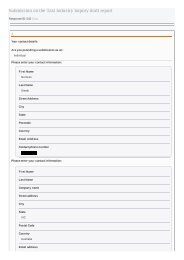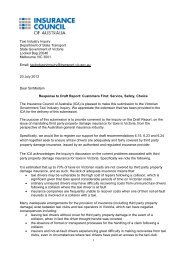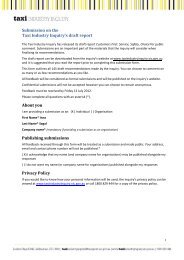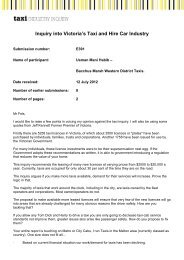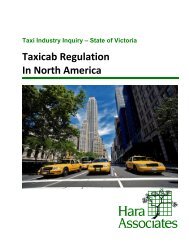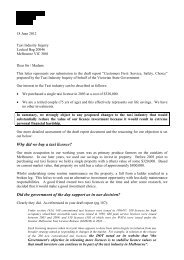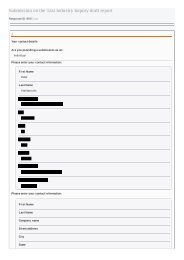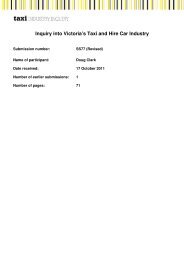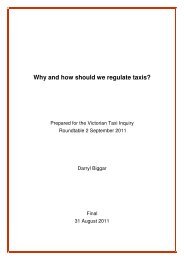Part D â Understanding and improving industry performance (PDF ...
Part D â Understanding and improving industry performance (PDF ...
Part D â Understanding and improving industry performance (PDF ...
Create successful ePaper yourself
Turn your PDF publications into a flip-book with our unique Google optimized e-Paper software.
Secondary networks – customer choice at work<br />
The inquiry has found high levels of satisfaction with the<br />
<strong>performance</strong> of secondary networks, with many regular<br />
taxi users commenting that these networks provide more<br />
reliable services than ‘st<strong>and</strong>ard’ taxi services. Benefits<br />
reported by secondary network taxi customers include<br />
knowing which driver is coming <strong>and</strong> when; having<br />
access to a regular <strong>and</strong> trusted driver; <strong>and</strong> being able to<br />
negotiate flat fares.<br />
Generally, these customers report having obtained the<br />
details of a particular driver or group of drivers from a<br />
friend or colleague. They then call the driver or network<br />
whenever they need a taxi.<br />
The consumer research conducted for the inquiry by<br />
Ipsos Social Research Institute also found that a number<br />
of taxi users attributed their positive experiences to<br />
having access to a secondary network. Ipsos reports that<br />
these users:<br />
…overwhelmingly found that such drivers<br />
provided a far higher quality of service than the<br />
st<strong>and</strong>ard, <strong>and</strong> were particularly pleased with<br />
their reliability. Secondary network taxis were<br />
also seen to be of a cleaner, more comfortable<br />
st<strong>and</strong>ard. Further, as booking a taxi through a<br />
secondary network bypasses the need to use a<br />
booking service, passengers are usually informed<br />
when the taxi will arrive <strong>and</strong> whether or not there<br />
will be a delay … 24<br />
Organisations working with people with a disability also<br />
report ‘bypassing’ the primary NSPs to form relationships<br />
with regular drivers <strong>and</strong> secondary networks. For<br />
example, Blind Citizens Australia comments:<br />
Many people who are blind or vision impaired choose<br />
to establish a direct relationship with one or two<br />
drivers, or a small network of drivers, with some<br />
members noting that this guarantees them a better<br />
quality service. 25<br />
The Ipsos research identified examples where accessing<br />
taxi services “was easy <strong>and</strong> customer centred in design”<br />
<strong>and</strong> noted that most of these examples came from users<br />
accessing services through a driver they know or a<br />
secondary network. The Ipsos report concludes:<br />
These services are seen to be comfortable, reliable<br />
<strong>and</strong> driven by professional, friendly drivers.<br />
Secondary network taxis also have benefits in terms<br />
of access in that they can be booked through direct<br />
contact with a driver, eliminating the need for booking<br />
services. This model should be considered in<br />
<strong>improving</strong> the broader taxi <strong>industry</strong>. 26<br />
11.3. History of taxi networks<br />
Taxi networks have played an integral role in forming<br />
the structure of the taxi <strong>industry</strong> in Victoria. This next<br />
section looks at their influence <strong>and</strong> evolution from<br />
representative organisations into the corporations that we<br />
see today. Their important role in leading innovation in the<br />
technology field is also analysed.<br />
11.3.1. Cooperative monopolies<br />
As described in chapter 6, the Transport Regulation<br />
Board (TRB) assumed responsibility for regulating the<br />
commercial passenger vehicle <strong>industry</strong> in Victoria in<br />
1952. The TRB found that while taxis were available<br />
within 5km of the city centre, Melbourne’s suburbs had<br />
very limited access to taxi services. To address this issue,<br />
the TRB divided suburban Melbourne into a number<br />
of taxi zones. Suburban taxi companies <strong>and</strong> individual<br />
operators were then amalgamated as ‘depots’ with the<br />
aim of ensuring that phone bookings for taxis could be<br />
met efficiently. This early structure for booked services<br />
contemplated – either consciously or not – that monopoly<br />
providers in each zone would offer the most efficient<br />
means of delivering a quality taxi service to customers.<br />
Typically, early taxi depots were member-based<br />
organisations run by taxi operators on a cooperative<br />
basis. Taxi operators were directly involved in the<br />
running of the depots <strong>and</strong> in making decisions about<br />
depot rules <strong>and</strong> activities. Depots also assisted their<br />
operator members by offering better buying power for<br />
consumables such as fuel, vehicle parts <strong>and</strong> repairs.<br />
Drivers were often placed in a common ‘pool’ by each<br />
depot <strong>and</strong> shared by the taxi operators.<br />
24 Ipsos Social Research Institute (2012), Op.Cit., p.80<br />
25 Blind Citizens Australia, Submission to the Taxi Industry Inquiry,<br />
SS155, p.2<br />
26 Ipsos Social Research Institute, Op. Cit., pp.96-97<br />
230




